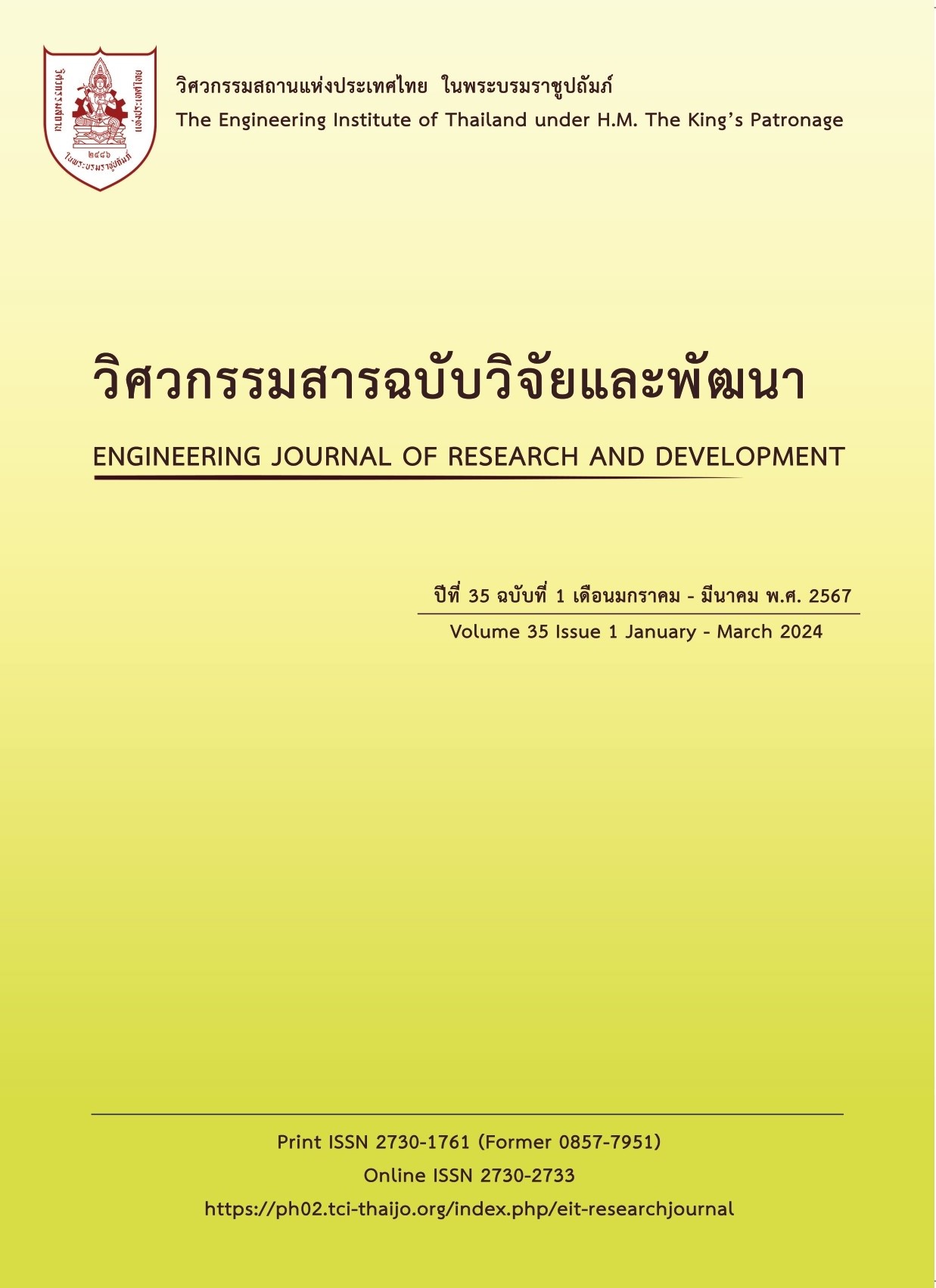THE RECYCLING OF SOIL CONTAMINATED WITH IRON RUST FOR FABRICATE CERAMIC TILES
Main Article Content
Abstract
The purpose of this research is to study the chemical properties of soil contaminated with iron rush. The study aims to determine the optimal mixing ratios of iron rush-contaminated soil with other soil and raw materials used in high-temperature firing for the development of ceramic tiles. The chemical analysis revealed that iron (Fe) was the element present in the highest quantity, with a concentration of 282,715 mg/L (141,357.5 mg/kg of contaminated soil). The composition of the iron-contaminated soil includes aluminum oxide (Al2O3), iron oxide (Fe2O3), potassium oxide (K2O), titanium dioxide (TiO2), manganese dioxide (MnO2), magnesium oxide (MgO), phosphorus pentoxide (P2O5), chloride (Cl), calcium oxide (CaO), chromium oxide (Cr2O3), nickel oxide (NiO), copper oxide (CuO), zinc oxide (ZnO), and sulfur trioxide (SO3). Among these components, Fe2O3 was found to be the most abundant, ranging from 72.04% to 78.85 % by molecular weight and loss of ignition (L.O.I.) 14.655%. The average density of the soil 1,632.50 kg/m3, the average moisture content 6.72 %. These values indicate that the density of the soil is similar to that of normal soil, which typically falls within the range of 1,492 kg/m3. The color of the soil is reddish-brown, resembling fired bricks. After the soil was developed into ceramic tiles, the physical properties were evaluated. The highest shrinkage, at 8.97%, was observed in the P60 formula fired at a temperature of 1,100 °C. The color of the tiles after firing varied from dark brown to orange, depending on the mixing ratio of the iron-contaminated soil, which contributes to the red-brown color. Increasing the proportion of iron-contaminated soil resulted in decreased tile strength, while higher firing temperatures increased tile strength. The highest flexural strength value, at 77.07 kg/cm2, was obtained from the P80 formula fired at 1,100 °C. The P80 tile formula exhibited water absorption of more than 10% and a modulus of rupture (MOR) of less than 7 N/m2, meeting the industrial standards (TSIS 2508-2555).
Article Details

This work is licensed under a Creative Commons Attribution-NonCommercial-NoDerivatives 4.0 International License.
The published articles are copyright of the Engineering Journal of Research and Development, The Engineering Institute of Thailand Under H.M. The King's Patronage (EIT).
References
Thanasarn. เหล็กรูปพรรณ, 2565. Available from: http://www.thanasarn.co.th/ [Accessed 18 สิงหาคม พ.ศ. 2565].
Chiara Zanelli, Sonia Conte, Chiara Molinari, Roberto Soldati and Michele Dondi. Waste recycling in ceramic tiles: a technological outlook. Resources. Conservation & Recycling, 2021, 168, p. 28.
เกษม พฤกษะวัน. การศึกษาประโยชน์ของดินตะกอนประปาจากกระบวนการผลิตน้ำประปา เพื่อใช้ในการผลิตผลิตภัณฑ์เซรามิก. ทุนวิจัยการประปานครหลวง, รายงานการวิจัย, 2545.
สุทธิดา การะเวก ศศิธร คนทน อนันตกลุ อินทรผดุง และ ธัชทฤต เทียมธรรม. การพัฒนาเนื้อดินผสมสำเร็จรูปจากดินตะกอนน้ำประปาสำหรับงานเครื่องปั้นดินเผา. วารสารวิจัยราชภัฏพระนคร สาขาวิทยาศาสตร์และเทคโนโลยี, 2562, 14(1) หน้า 117-136.
ณัฐพล ฐาตุจิรางค์กุล และ คำภี จิตชัยภูมิ. คุณสมบัติทางกายภาพของดินเหนียวเผามวลเบาทำจากไดอะตอมไมต์ผสมโฟม. การประชุมวิชาการวิศวกรรมโยธาแห่งชาติ ครั้งที่ 25, การประชุมรูปแบบออนไลน์, 15-17 กรกฎาคม 2563, หน้า 1- 8.
นนทพงษ์ พลพวก. การพัฒนากระบวนการผลิตอิฐมอญโดยใช้เศษแก้วเป็นสารเติมแต่ง. วารสารวิทยาศาสตร์และเทคโนโลยี มหาวิทยาลัยราชภัฏศรีสะเกษ, 2564, 1(2) หน้า 1-11.
Velasco, P.M., Morales Ortiz, M.P., Mendivil Giro, M.A., Velasco, L.M. Fired clay bricks manufactured by adding wastes as sustainable construction material – A review. Construction and Building Materials, 2014, 63, pp. 97-107.
เกษม พฤกษะวัน. การศึกษาความเหมาะสมของดินตำบลโคกไม้ลาย จังหวัดปราจีนบุรีเพื่อใช้ผลิตเซรามิก ตอนที่ 1 การผลิตเนื้อดินสำหรับการหล่อโดยการเติมดินขาวลำปาง. วารสารรามคำแหง ฉบับวิทยาศาสตร์และเทคโนโลยี ฉบับวิทยาศาสตร์และเทคโนโลยี, 2556, 30(2) หน้า 98-117.
เกษม พฤกษะวัน และ อัศนีย์ แจ่มกล่ำ. การพัฒนาดินเหนียวกรุงเทพฯ เพื่อผลิตเซรามิก. Srinakharinwirot Science Journal, 2557, 30(2) หน้า 131-149


